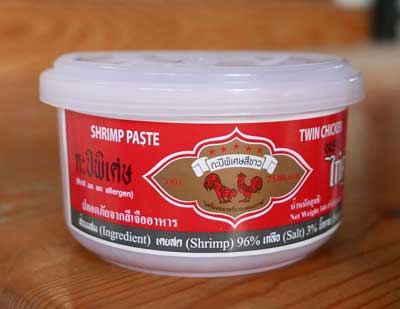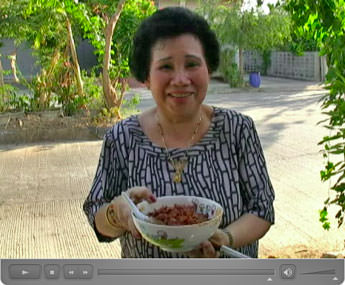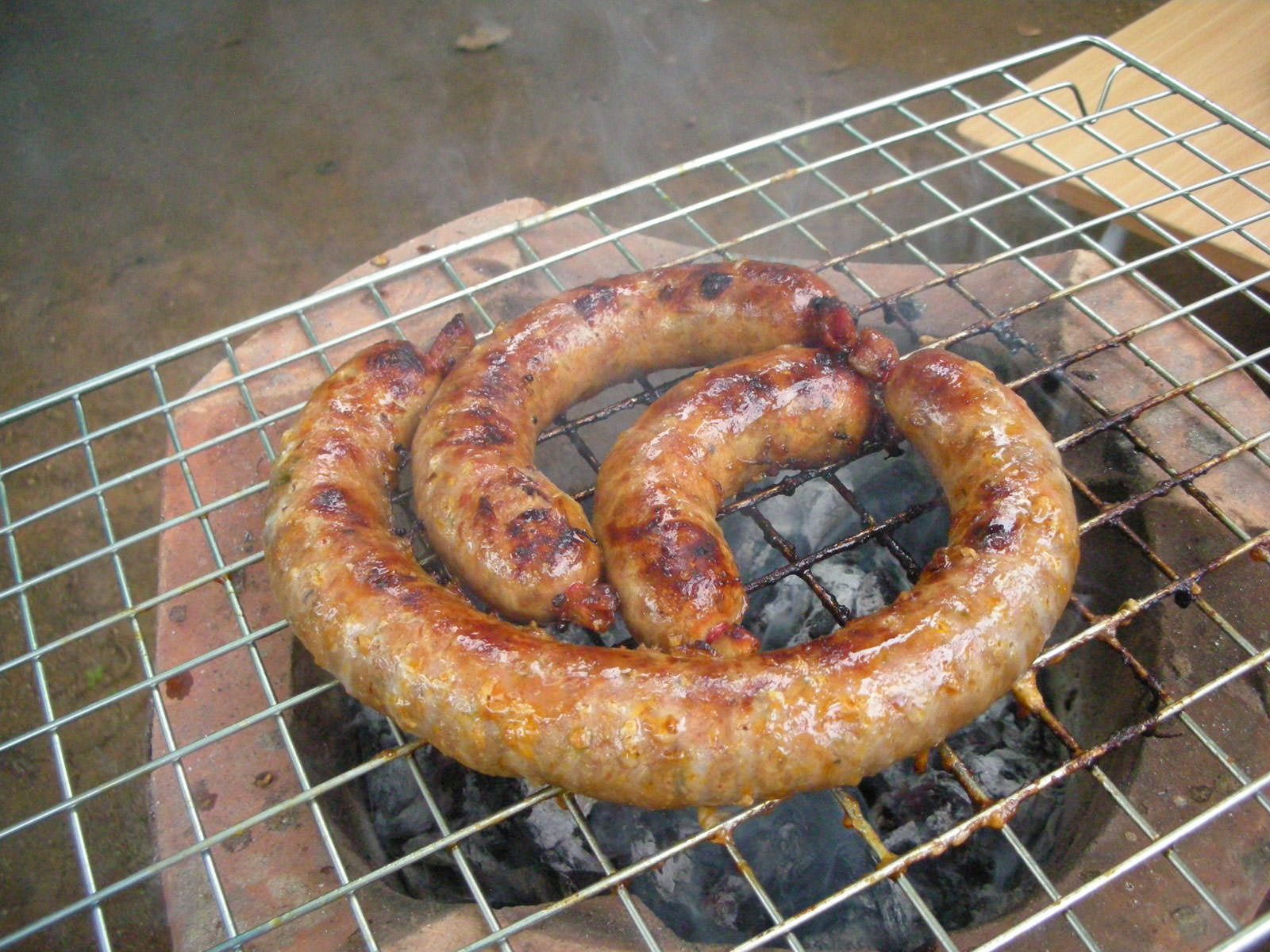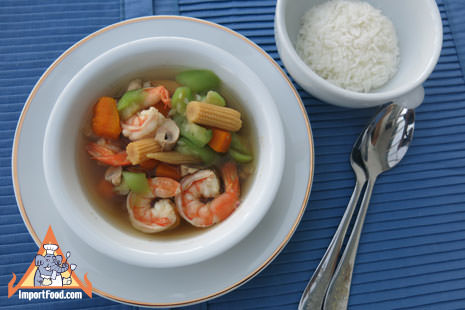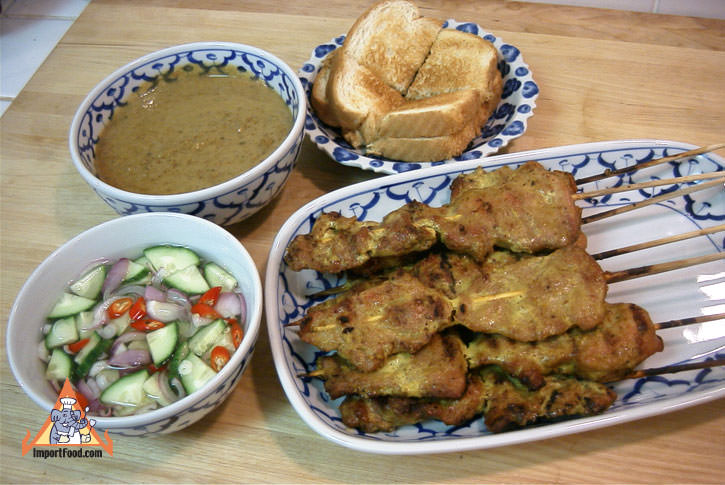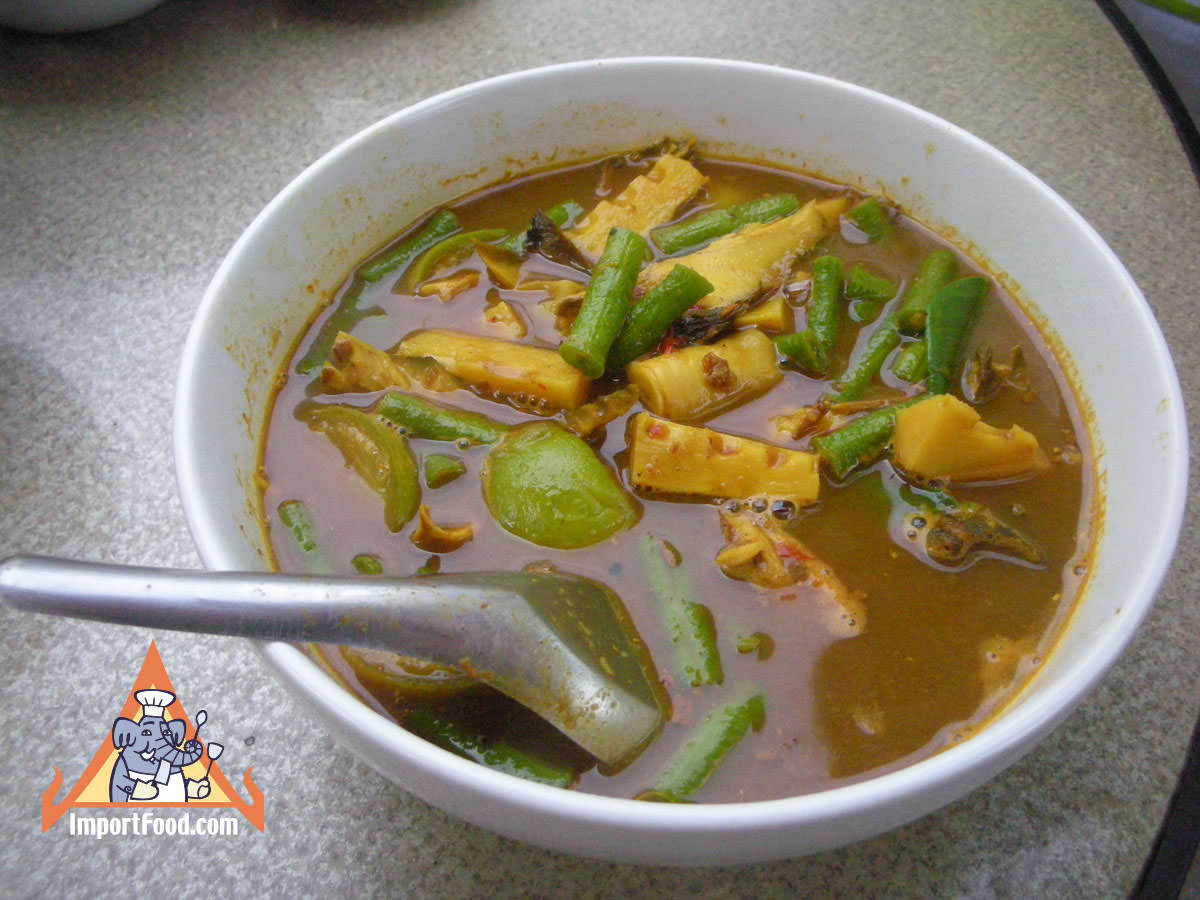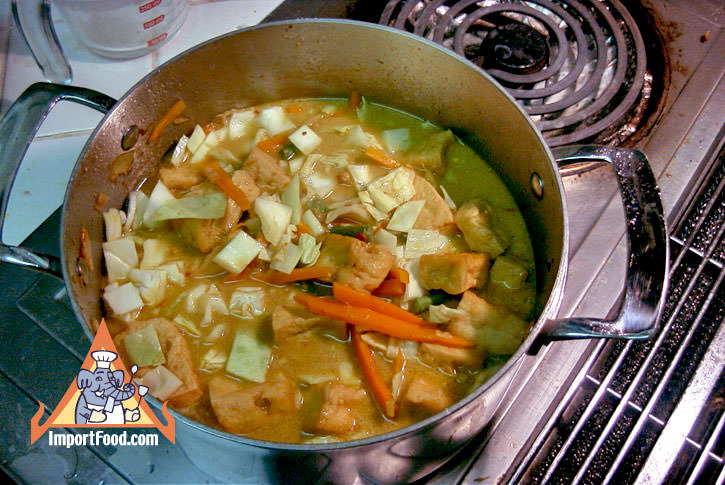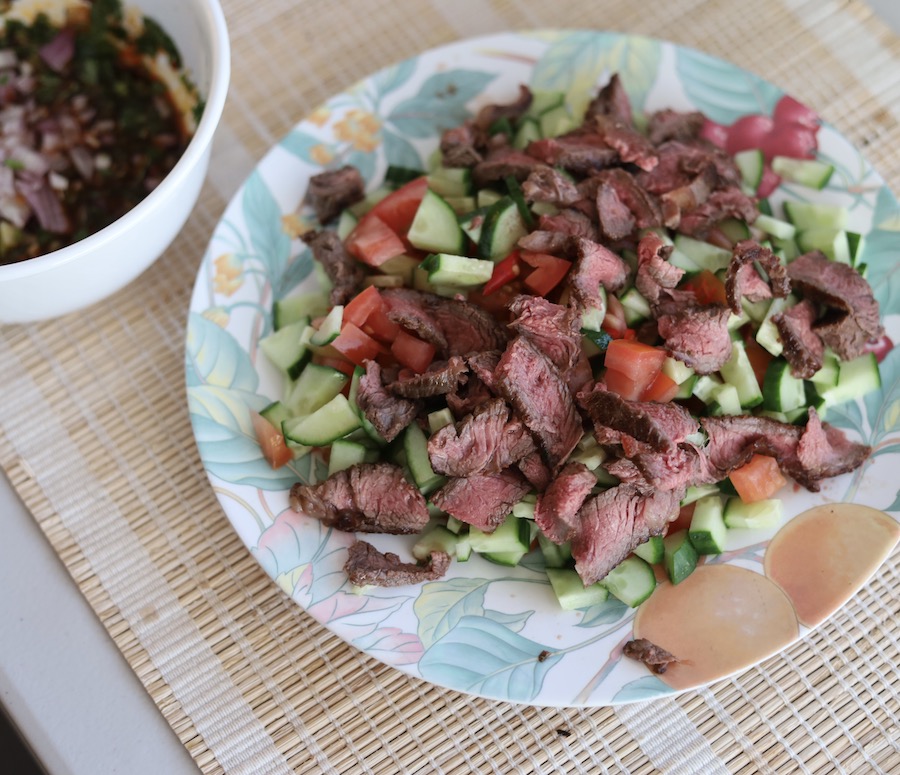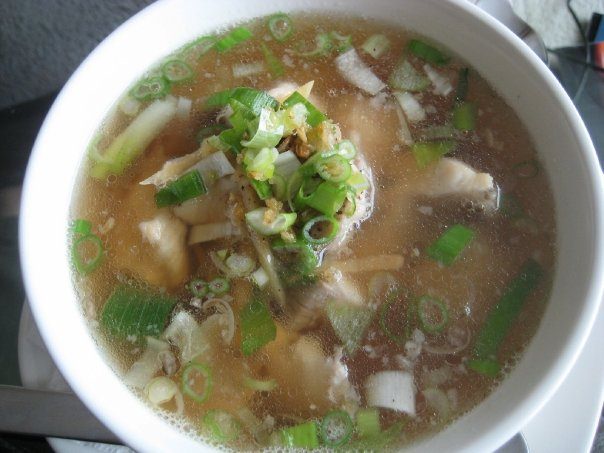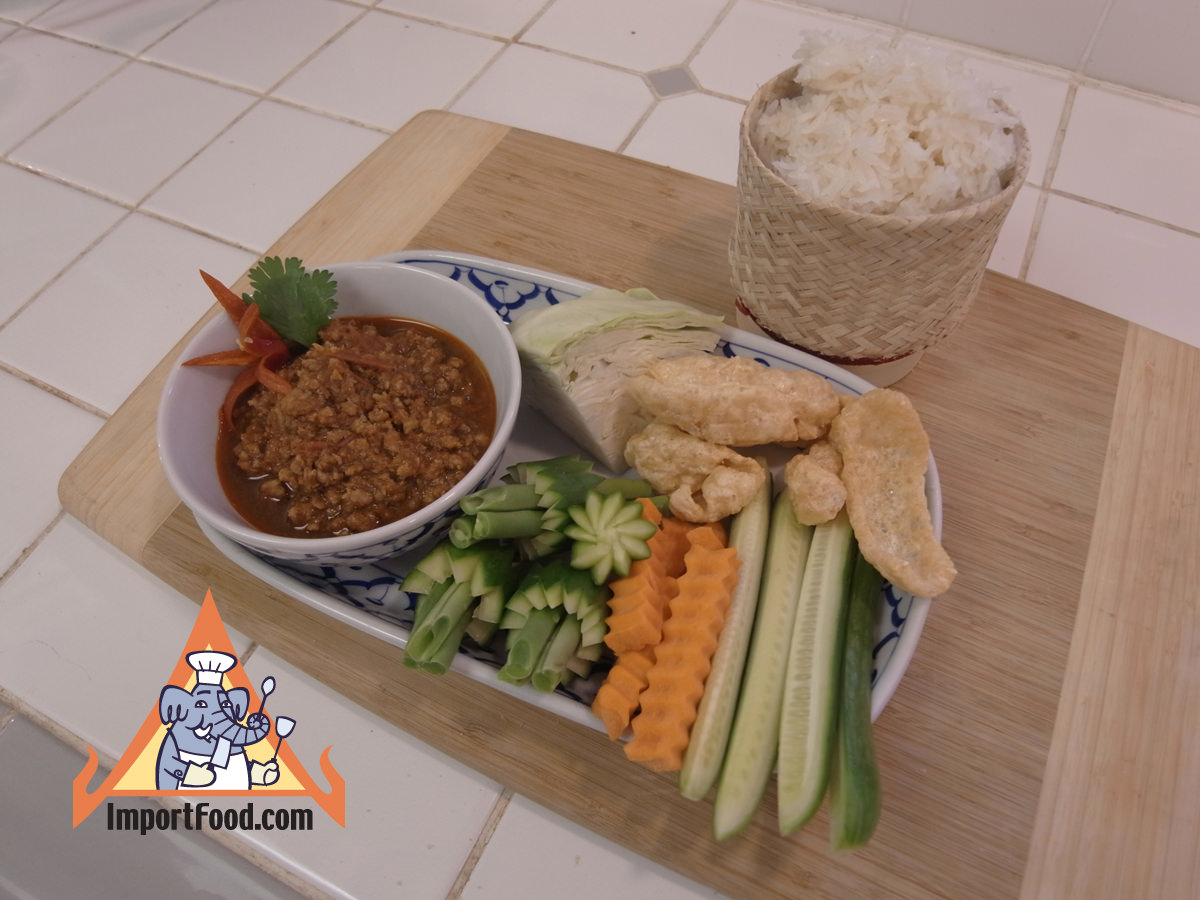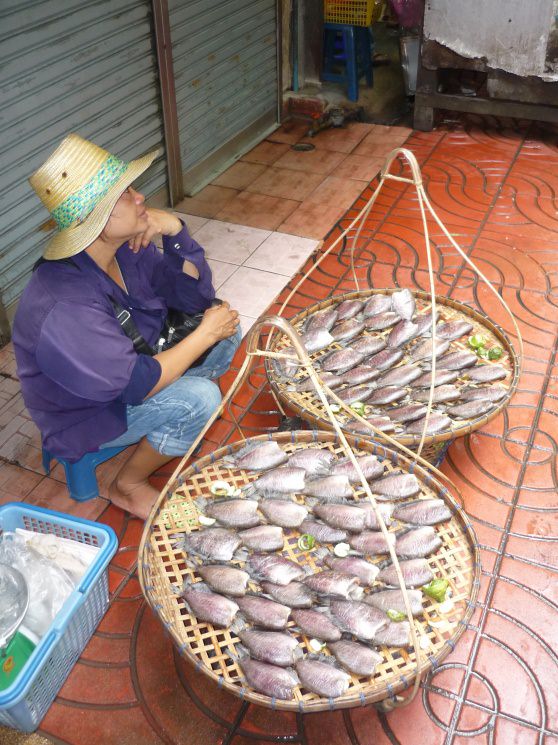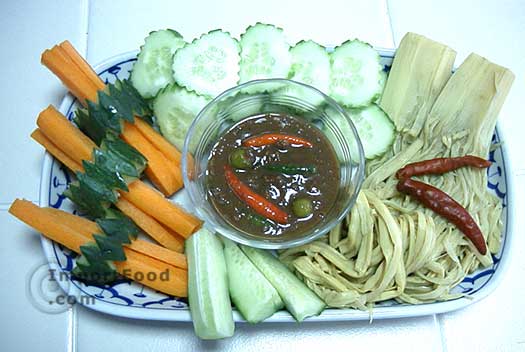Thai Shrimp Paste
Add to cart12oz - $12.75 Twin Chicken brand is a well-known, long term brand that's been famous in Thailand for generations. Expect consistent quality and good aroma. We are shipping the large 12 oz size, and please limit one per order as it is hard to get.
Made using the finest shrimp, packed in the most hygenic conditions. See our photo tour showing how shrimp paste is made.
A key ingredient in authentic Thai recipes listed below, shrimp paste is made from fresh shrimp and salt. A strong-smelling and very important element of all kinds of Thai curry paste. You'll love it in gaeng hanglay.
Packed in convenient plastic tub with tighly sealed lid, in a large 12 oz size. This is more than most people use at home so expect it to last quite awhile. Keep in a ziplock in your pantry for best results, as that contains the strong smell.
This is a fairly large size (6 oz), and will last a long time.
Ingredients: krill, salt, sugar, msg. Product of Thailand.
Watch our feature "Shrimp Paste used to make Prik Pao"
Shrimp paste used in the following Thai recipes:
Northern Thai Pork Curry, 'Gaeng Hanglay'
In our continuing effort to present regional Thai recipes, here is an authentic version of Gaeng Hanglay, a northern Thai curry made with pork (or beef). Similar to massaman but without the coconut milk. The main ingredient is pork or beef, and you can use a fatty belly pork or other cut of your choice. Other distinctive ingredients are ginger and pickled garlic.
Thanks to our authentic Hunglay Powder from Thailand you can make a real masterpiece.
Some recipes call for Santol fruit (wild mangosteen) or pineapple cut into large cubes. We used fresh pineapple with good results. This dish originated from Burma, and in Burma this is usually served with Khai bananas (small bananas). You will usually find gaeng hanglay served in Khantok-style Thai dinners as one of the main dishes, together with sticky rice.
Northern Thai Sausage, 'Sai Oua'
Northern Thai sausage is easy to make, and the mix of ingredients leads to a spectacular result. We would encourage you to make this with ground pork or, for any hunters reading, try this with local elk, deer, wild boar, or other natural meat that you might have. Also watch our video (below left) showing how it's made.
You can't go wrong with this sausage. Please be sure to leave us a comment using the form below if you make it, and share how it turned out.
We also have a recipe for Esan-style Thai sausage, sai grok.
Thai Vegetable Soup, 'Kaeng Liang'
As opposed to tom jabchai, this *is* a vegetarian dish. Though normally included in Thailand, the curry paste and chili beans in oil can be considered optional for those who are looking for something with a little less heat. You can use any vegtables available, but typically in Thailand it would be made from a gourd. If one of the gourds is used it is cut into bite sized chunks first. We now offer an instant kaeng liang mix.
Thai Pork Satay, 'Moo Satay'
Pork satay consists of strips of marinated pork on bamboo skewers, charcoal barbequed then served with a tasty peanut sauce and a white vinegar cucumber sauce. It's often served in Thailand with squares of toast, as shown in our recipe here. We made pork satay in the true authentic Thai style, which is time-consuming. Be sure to baste your satay as it's on the barbeque, note from our street vendor video (below left) he is constantly basting. It seems that most of the time, this style of satay is made with pork, but you can also find chicken satay and prawn satay. We offer a ready-made satay mix that's quite good for both chicken and pork.
Recently we had a fantastic meal using this recipe, prepared with our high-fat Chaokoh coconut cream rather than coconut milk, and we omitted the peanuts altogether which led to a very rich, slightly spicy satay full of true Thai flavors (see pictures below right).
There are four different things you need to make: marinade, basting sauce, satay sauce, and ajad.
Gaeng Tai Pla
Gaeng Tai Pla is a legendary recipe developed by people in the fishing communities of Southern Thailand. They wanted to find a way to use the fish guts rather than toss them out, so they developed a pickling process of the fish bladder. The pickled fish bladder (Tai Pla) is used to make this soup using a heavy dose of local spices and large chunks of dried fish meat.
Lately people all over Thailand crave the Tai Pla that comes from various regions, and packed in different brands. In this recipe we show you every step in the process, also see our video feature of a chef from Trang in Southern Thailand making Gaeng Tai Pla. As authentic as it gets, and we do offer a high quality imported Tai Pla so you can make this at home using the best ingredients. Please enjoy this feature and share your comments below.
Vegetable Curry, 'Sayur Lodeh'
This recipe was featured in the October 2008 issue of Saveur Magazine, which is one of the most beautiful isues of a cooking magazine ever published. We already love Saveur but their Breakfast Issue of October 2008, featuring breakfast served around the world, was spectacular. We were so pleased to be featured as a supplier for the ingredients necessary to make Sayur Lodeh, a Singaporean vegetable curry.
Sayur Lodeh takes awhile to prepare, at least 1 hour, so be patient. It has an excellent aroma, and the final result is very rich and full of creamy, healthy, herbal flavor. The candlenuts add a wonderful nutty flavor. The chile peppers gives it a nice spicy edge also.
In Singapore this dish is often served for breakfast with toasted coconut, sambal, and steamed jasmine rice.
After serving sayur lodeh, we added a few drops of soy sauce to each dish for a nice added seasoning.
Saveur states that this serves four but we think it's more like an 8 person serving size, with jasmine rice.
Thai Beef Salad, 'Yum Nuea'
One of our favorite recipes, the meat is pan fried or barbequed then tossed with a delicious mixture of sweet, sesame-inspired smoky hot sauce and fresh vegetables. It should be served with jasmine rice, but it's also delicious with sticky rice (soaking up the sauce).
Yam nuea literally means "tossed beef". This is a simple beef "salad", and can be eaten hot or cold. This should be on the hot side of neutral, but really is more spicy than "hot". It is normal to add sunstantial amounts of hot condiments to it to suit yourself (see the section on condiments below).
Thai Chicken Casserole, 'Gai Kaeng'
This is a 'Thai-ised' version of a recipe from Delia Smith's cooking course, called Chicken with Whole Spice, which is a mild pastiche on Indian food. This version is set up for a slow-crock cooker, but it could be prepared as a conventional casserole by simmering it on the stove top for about 30 minutes or in an oven at about 180 C for 30 minutes or so.
Thai Steamed Fish with Ginger and Mushrooms, 'Pla Nung Khing Sai Het'
Traditionally this is prepared with the fish known in the West as a pomfret, but any similar (flat) fish will do.
This is steamed, and as such is best done in a bamboo steamer, because in a metal steamer condensation on the lid drips onto the food and marks it, spoiling the appearance and also possibly affecting the cooking process (fish is best steamed in "dry" steam). If you use a metal steamer you should cover the fish with a paper towel which is not in direct (or limited) contact with the steamer. Alternatively you can cook this dish in a microwave, using low to medium power.
Clean the fish and score the sides with several cuts to allow the marinade to penetrate.
Thai Dipping Sauce From Hell, 'Nam Prik Narok'
This recipe is normally made from sun dried chilis. You can chop fresh chilis and spread them on a cookie tray and put them under the broiler until fairly dry. This sauce keeps well, and is popular as "traveler's fare" in Thailand, being used as an accompaniment to various dried meats and sliced vegetables. We now offer an excellent premade Narok chile paste.
Spicy Pork and Tomato Dip with Veggies, 'Nam Prik Ong'
This authentic Thai recipe is a regional delight which originated in the north of Thailand. When completed it looks a bit like sloppy joes, or taco filling.
The main ingredients are ground fatty pork and small tomatoes. In this recipe, we use a delicious prepared "Prik Khing curry Paste". The final dish has a sour, sweet and salty taste.
If you have fresh ripe local tomatoes, it really makes the final result outstanding.
Serve this as a main course with sticky rice, fresh vegetables such as cucumbers, green beans, wedges of cabbage and pieces of fried pork skin are recommended.
Thai-Style Fried Fish, 'Pla Jian'
This is another simple traditional treatment for fish: this time it is deep fried. The recipe includes some minced pork: this can easily be omitted. It is included in this case only to reproduce the traditional taste, as in the past this dish was deep fried in pork fat, which transferred the pork flavor to the fish. Today it would more typically be fried in vegetable oil, hence the small quantity of pork.
Equally traditionally this dish is deep fried in a wok
The fish is normally fried with the head on.
You need a small-to-medium flat fish (pomfret, flounder, ...), cleaned and with the sides slashed for the marinade to penetrate.
Thai Shrimp Paste Chile Sauce, 'Nam Prik Kapi'
This recipe is for a very aromatic dipping sauce that is not typically something the American nose will appreciate, but drives the Thai person wild with memories of home (see photo below). Namprik Kapi has a pungent fishy smell and lingers on your breath for hours, but it's truly "authentic" and if you know someone who boasts of being adventurous with food, see if (s)he can tolerate a dish of this. It's a wonderful accompaniment to Lao style vegetarian curry.
We also offer an instant ready-made namprik kapi.
Gai Muang Nung Kreung Gaeng Nua, Steamed Chicken Chiang Mai
In English you could call this "chicken in northern style chile paste". The Chiang Mai (northern Thai) chile paste has mild flavor (not spicy), made with turmeric, using local Thai chicken which are tasty and chewy. For best results, use the finest quality chicken you can find. We used organic free-range chicken breasts cut up into large chunks, with excellent results.
Traditionally, to prepare northern style steamed chicken, the chicken cavity would be stuffed with the chile paste. This recipe is prepared using the traditional turmeric chile paste but cooked a different way. Inspired by a chef focused on recipes of the old Chiang Mai culture.

